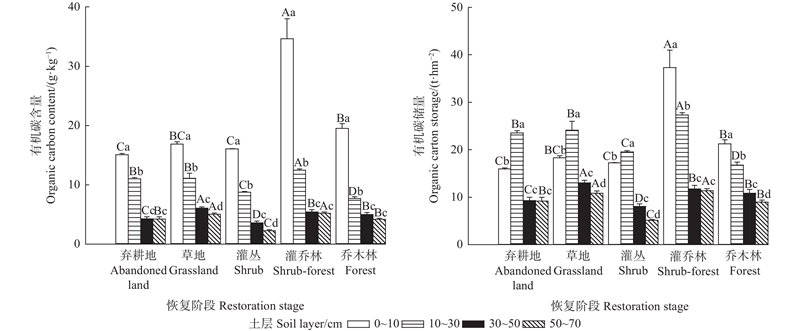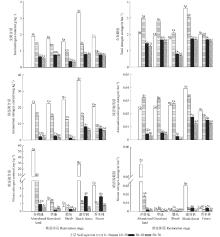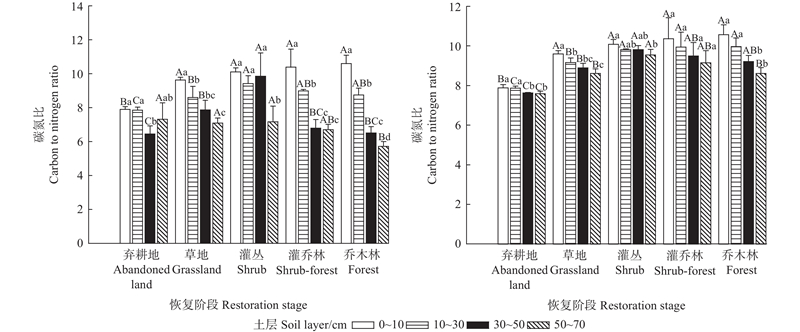

Scientia Silvae Sinicae ›› 2023, Vol. 59 ›› Issue (7): 45-53.doi: 10.11707/j.1001-7488.LYKX20220014
• Research papers • Previous Articles Next Articles
Yuejin Zhang( ),Qinyi Li,Haocai Wang,Weiyu Shi*
),Qinyi Li,Haocai Wang,Weiyu Shi*
Received:2022-01-07
Online:2023-07-25
Published:2023-09-08
Contact:
Weiyu Shi
E-mail:1490957274@qq.com
CLC Number:
Yuejin Zhang,Qinyi Li,Haocai Wang,Weiyu Shi. Characteristics of Soil Carbon and Nitrogen Storage in Typical Communities of Natural Restoration and Succession of Vegetation in Karst Areas of Southwest China[J]. Scientia Silvae Sinicae, 2023, 59(7): 45-53.
Table 1
Basic?situation?of?sampling?points"
| 植被恢复阶段 Vegetation restoration?stage | 经/纬度 Longitude/ latitude | 海拔 Altitude/m | 坡度 Slope/(°) | 植被盖度 Vegetation cover | 物种丰富度 Species? richness | 恢复年限 Restoration? years/a |
| 弃耕地 Abandoned?land | 106°26′35.16″E 29°47′15.72″N | 588 | 2 | 0.05±0.01 | — | 0.5 |
| 草地 Grassland | 106°26′34.80″E 29°47′15.72″N | 588 | 5 | 0.75±0.13 | 8±2 | 5?~?10 |
| 灌丛 Shrub | 106°26′41.28″E 29°47′4.56″N | 563 | 19 | 0.60±0.11 | 11±3 | 15~25 |
| 灌乔林 Shrub-forest | 106°26′28.68″E 29°46′48.36″N | 578 | 27 | 0.70±0.23 | 21±3 | 30~40 |
| 乔木林 Forest | 106°26′22.92″E 29°46′42.6″N | 574 | 23 | 0.80±0.17 | 23±3 | 50~60 |
Table 2
Effects?of?vegetation?restoration?stage,?soil?depth?and?their?interaction?on?soil?carbon?and?nitrogen?content?and?storage,?C/N"
| 因素 Factors | 土壤有机碳 Soil?organic? carbon(SOC) | 土壤全氮 Soil?total? nitrogen(TN) | 土壤碳氮比 Soil?carbon?to?nitrogen? ratio(C/N) | 土壤有机碳储量 Soil?organic?carbon? storage(Cs) | 土壤全氮储量 Soil?total?nitrogen? storage(Ns) |
| 恢复阶段 Restoration?stage | 118.546*** | 2000.404*** | 13.705*** | 119.422*** | 2038.402*** |
| 土层深度 Soil?depth | 1199.602*** | 10786.149*** | 69.966*** | 1190.698*** | 14972.842*** |
| 恢复阶段×土层深度 Restoration?stage?×?soil?depth | 62.459*** | 689.225*** | 6.450*** | 62.563*** | 697.308*** |

Fig.1
Content?and?storage?of?organic?carbon?at?different?vegetation?restoration?stages Different?capital?letters?indicate?significant?differences?between?different?restoration?stages?in?the?same?soil?layer?(P?<?0.05),?and?different?lowercase?letters?indicate?significant?differences?between?different?soil?layers?at?the?same?restoration?stage?(P?<?0.05)."


Fig.2
Content?and?storage?of?soil?nitrogen?at?different?vegetation?restoration?stages Different?capital?letters?indicate?significant?differences?between?different?restoration?stages?in?the?same?soil?layer?(P?<?0.05),?and?different?lowercase?letters?indicate?significant?differences?between?different?soil?layers?at?the?same?restoration?stage?(P?<?0.05)."


Fig.3
Soil?carbon?and?nitrogen?ratio?at?different?vegetation?restoration?stages Different?capital?letters?indicate?significant?differences?between?different?restoration?stages?in?the?same?soil?layer?(P?<?0.05),?and?different?lowercase?letters?indicate?significant?differences?between?different?soil?layers?at?the?same?restoration?stage?(P?<?0.05)."

Table 3
Correlation?between?soil?carbon?and?nitrogen?storage?and?soil?chemical?properties?at?different?restoration?stages"
| 组分 Items | pH | 土壤 有机碳 Soil?organic?carbon (SOC) | 土壤 全氮 Soil?total?nitrogen (TN) | 土壤 碳氮比 Soil?carbon?to?nitrogen?ratio (C/N) | 土壤 有机碳储量 Soil?organic? carbon?storage (Cs) | 土壤 全氮储量 Soil?total???????nitrogen?storage (Ns) | 土壤 全磷 Soil?total?phosphorus (TP) | 土壤 全钾 Soil?total?potassium (TK) | 土壤 铵态氮 Soil?ammonium?nitrogen (NH4+-N) | 土壤 硝态氮 Soil?nitrate?nitrogen (NO3?-N) |
| pH | 1 | |||||||||
| SOC | ?0.050 | 1 | ||||||||
| TN | ?0.089 | 0.981** | 1 | |||||||
| C/N | ?0.133 | 0.681** | 0.569** | 1 | ||||||
| Cs Ns TP TK NH4+-N | ?0.045 ?0.082 ?0.554** 0.426** ?0.212 | 1.000** 0.983** 0.504** ?0.273** 0.948** | 0.982** 1.000** 0.589** ?0.192 0.960** | 0.686** 0.576** 0.271* ?0.583** 0.630** | 1 0.980** 0.498** ?0.278* 0.947** | ??????? 1 0.582** ?0.200 0.960** | 1 ?0.128 0.623** | 1 ?0.354** | 1 | |
| NO3?-N | ?2.252 | 0.535** | 0.622** | 0.134 | 0.526** | 0.611** | 0.659** | 0.041 | 0.559** | 1 |
| 鲍士旦. 2000. 土壤农化分析. 北京: 中国农业出版社. | |
| Bao S D. 2000. Soil agricultural chemical analysis. Beijing: China Agriculture Press.[in Chinese] | |
| 陈 静, 朱大运, 陈 浒, 等. 石漠化区生态治理措施对土壤团聚体稳定性及有机碳的影响. 长江流域资源与环境, 2021, 30 (9): 2236- 2244. | |
| Chen J, Zhu D Y, Chen H, et al. Effects of ecological management measures on soil aggregate stability and organic carbon in rocky desertification areas. Resources and Environment of the Yangtze River Basin, 2021, 30 (9): 2236- 2244. | |
|
陈为峰, 史衍玺, 田素锋, 等. 黄河口新生湿地土壤氮磷分布特征研究. 水土保持学报, 2008, 22 (1): 69- 73.
doi: 10.3321/j.issn:1009-2242.2008.01.015 |
|
|
Chen W F, Shi Y X, Tian S F, et al. Distribution characteristics of soil nitrogen and phosphorus in new wetland of Yellow River Estuary. Journal of Soil and Water Conservation, 2008, 22 (1): 69- 73.
doi: 10.3321/j.issn:1009-2242.2008.01.015 |
|
| 邸月宝, 王辉民, 马泽清, 等. 亚热带森林生态系统不同重建方式下碳储量及其分配格局. 科学通报, 2012, 57 (17): 1553- 1561. | |
| Di Y B, Wang H M, Ma Z Q, et al. Carbon storages and its allocation pattern of forest ecosystems with different restoration methods in subtropical. Chinese Science Bulletin, 2012, 57 (17): 1553- 1561. | |
| 高艳丽, 杨智杰, 张 丽, 等. 不同更新方式对亚热带常绿阔叶林土壤氮矿化的影响. 林业科学, 2021, 57 (4): 24- 31. | |
| Gao Y L, Yang Z J, Zhang L, et al. Effects of different regenerated models on soil nitrogen mineralization in subtropical evergreen broad-leaved forest. Scientia Silvae Sinicae, 2021, 57 (4): 24- 31. | |
|
辜 翔, 张仕吉, 刘兆丹, 等. 中亚热带植被恢复对土壤有机碳含量、碳密度的影响. 植物生态学报, 2018, 42 (5): 595- 608.
doi: 10.17521/cjpe.2018.0021 |
|
|
Gu X, Zhang S J, Liu Z D, et al. Effects of vegetation restoration on soil organic carbon concentration and density in the midsubtropical region of China. Chinese Journal of Plant Ecology, 2018, 42 (5): 595- 608.
doi: 10.17521/cjpe.2018.0021 |
|
| 何高迅, 王 越, 彭淑娴, 等. 滇中退化山地不同植被恢复下土壤碳氮磷储量与生态化学计量特征. 生态学报, 2020, 40 (13): 4425- 4435. | |
| He G X, Wang Y, Peng S X, et al. Soil carbon, nitrogen and phosphorus storages and ecological stoichiometry characteristics under different vegetation restoration in degraded mountainous areas of central Yunnan. Acta Ecologica Sinica, 2020, 40 (13): 4425- 4435. | |
|
胡 宁, 马志敏, 蓝家程, 等. 石漠化山地植被恢复过程土壤团聚体氮分布及与氮素矿化关系研究. 环境科学, 2015, 36 (9): 3411- 3421.
doi: 10.13227/j.hjkx.2015.09.037 |
|
|
Hu N, Ma Z M, Lan J C, et al. Distribution of soil aggregate nitrogen and its relationship with nitrogen mineralization during vegetation restoration in rocky desertification mountainous areas. Environmental Science, 2015, 36 (9): 3411- 3421.
doi: 10.13227/j.hjkx.2015.09.037 |
|
|
李智超, 张勇强, 宋立国, 等. 江西大岗山不同林龄杉木人工林土壤碳氮储量. 中南林业科技大学学报, 2019, 39 (10): 116- 122.
doi: 10.14067/j.cnki.1673-923x.2019.10.017 |
|
|
Li Z C, Zhang Y Q, Song L G, et al. Soil carbon and nitrogen reserves of Chinese fir plantations of different ages in Dagangshan, Jiangxi. Journal of Central South University of Forestry and Technology, 2019, 39 (10): 116- 122.
doi: 10.14067/j.cnki.1673-923x.2019.10.017 |
|
|
刘玉林, 朱广宇, 邓 蕾, 等. 黄土高原植被自然恢复和人工造林对土壤碳氮储量的影响. 应用生态学报, 2018, 29 (7): 2163- 2172.
doi: 10.13287/j.1001-9332.201807.005 |
|
|
Liu Y L, Zhu G Y, Deng L, et al. Effects of natural vegetation restoration and artificial afforestation on soil carbon and nitrogen storages in the Loess Plateau. Chinese Journal of Applied Ecology, 2018, 29 (7): 2163- 2172.
doi: 10.13287/j.1001-9332.201807.005 |
|
|
罗 达, 冯秋红, 史作民, 等. 岷江干旱河谷区岷江柏人工林碳氮储量随林龄的动态. 应用生态学报, 2015, 26 (4): 1099- 1105.
doi: 10.13287/j.1001-9332.20150107.001 |
|
|
Luo D, Feng Q H, Shi Z M, et al. The dynamics of carbon and nitrogen storages of cypress plantation in arid valley of Minjiang River with forest age. Chinese Journal of Applied Ecology, 2015, 26 (4): 1099- 1105.
doi: 10.13287/j.1001-9332.20150107.001 |
|
| 吕 刚, 王 婷, 李叶鑫, 等. 樟子松固沙林更新迹地草本植物多样性及其对土壤理化性质的影响. 生态学报, 2017, 37 (24): 8294- 8303. | |
| Lü G, Wang T, Li Y X, et al. Diversity of herbaceous plants and their effects on soil physicochemical properties in Pinus sylvestris sand-fixing forest regeneration site . Acta Ecologica Sinica, 2017, 37 (24): 8294- 8303. | |
|
史利江, 高 杉, 姚晓军, 等. 晋西北黄土丘陵区不同植被恢复下的土壤碳氮累积特征. 生态环境学报, 2021, 30 (9): 1787- 1796.
doi: 10.16258/j.cnki.1674-5906.2021.09.002 |
|
|
Shi L J, Gao S, Yao X J, et al. Soil carbon and nitrogen accumulation characteristics under different vegetation restoration in loess hilly areas of northwestern Shanxi. Journal of Ecological Environment, 2021, 30 (9): 1787- 1796.
doi: 10.16258/j.cnki.1674-5906.2021.09.002 |
|
| 王瑞璋, 黎建强, 杨关吕, 等. 2019. 磨盘山典型森林生态系统土壤营养元素储量及其价值量评估. 西部林业科学, 48(6): 93−99. | |
| Wang R Z, Li J Q, Yang G L, et al. 2019. The storages and value assessment of soil nutrient elements in typical forest ecosystems in Mt. Mopan, China. Journal of West China Forestry Science, 48(6): 93−99.[in Chinese] | |
|
王绍强, 于贵瑞. 生态系统碳氮磷元素的生态化学计量学特征. 生态学报, 2008, 28 (8): 3937- 3947.
doi: 10.3321/j.issn:1000-0933.2008.08.054 |
|
|
Wang S Q, Yu G R. Ecological stoichiometric characteristics of carbon, nitrogen and phosphorus in ecosystem. Acta Ecologica Sinica, 2008, 28 (8): 3937- 3947.
doi: 10.3321/j.issn:1000-0933.2008.08.054 |
|
|
王振鹏, 陈金磊, 李尚益, 等. 湘中丘陵区不同恢复阶段森林生态系统的碳储量特征. 林业科学, 2020, 56 (5): 19- 28.
doi: 10.11707/j.1001-7488.20200503 |
|
|
Wang Z P, Chen J L, Li S Y, et al. Characteristics of forest ecosystem carbon stocks at different vegetation restoration stages in hilly area of central Hunan Province, China. Scientia Silvae Sinicae, 2020, 56 (5): 19- 28.
doi: 10.11707/j.1001-7488.20200503 |
|
|
徐 丽, 于贵瑞, 何念鹏. 1980s—2010s中国陆地生态系统土壤碳储量的变化. 地理学报, 2018, 73 (11): 2150- 2167.
doi: 10.11821/dlxb201811008 |
|
|
Xu L, Yu G R, He N P. Changes in soil carbon storages of terrestrial ecosystems in China from 1980s to 2010s. Acta Geographica Sinica, 2018, 73 (11): 2150- 2167.
doi: 10.11821/dlxb201811008 |
|
|
杨 怡, 欧洋运东, 陈 浩, 等. 西南喀斯特区植被恢复对土壤氮素转化通路的影响. 环境科学, 2018, 39 (6): 2845- 2852.
doi: 10.13227/j.hjkx.201710066 |
|
|
Yang Y, Ouyang Y D, Chen H, et al. Effects of vegetation restoration on soil nitrogen transformation pathway in southwest karst area. Environmental Science, 2018, 39 (6): 2845- 2852.
doi: 10.13227/j.hjkx.201710066 |
|
| 余 健, 房 莉, 卞正富, 等. 土壤碳库构成研究进展. 生态学报, 2014, 34 (17): 4829- 4838. | |
| Yu J, Fang L, Bian Z F, et al. Research progress of soil carbon pool composition. Acta Ecologica Sinica, 2014, 34 (17): 4829- 4838. | |
|
张春华, 王宗明, 居为民, 等. 松嫩平原玉米带土壤碳氮比的时空变异特征. 环境科学, 2011, 32 (5): 1407- 1414.
doi: 10.13227/j.hjkx.2011.05.014 |
|
|
Zhang C H, Wang Z M, Ju W M, et al. The spatial and temporal variation characteristics of soil C/N ratio in maize belt of Songnen Plain. Environmental Science, 2011, 32 (5): 1407- 1414.
doi: 10.13227/j.hjkx.2011.05.014 |
|
|
张 刚, 王德建, 王 灿. 不同农田施肥方式下土壤碳氮变化特征及其环境意义. 中国农学通报, 2013, 29 (32): 303- 308.
doi: 10.3969/j.issn.1000-6850.2013.32.056 |
|
|
Zhang G, Wang D J, Wang C. Variation characteristics of soil carbon and nitrogen under different farmland fertilization methods and their environmental significance. Chinese Agricultural Science Bulletin, 2013, 29 (32): 303- 308.
doi: 10.3969/j.issn.1000-6850.2013.32.056 |
|
|
张希彪, 上官周平. 人为干扰对黄土高原子午岭油松人工林土壤物理性质的影响. 生态学报, 2006, 26 (11): 3685- 3695.
doi: 10.3321/j.issn:1000-0933.2006.11.022 |
|
|
Zhang X B, Shangguan Z P. Effect of human-induced disturbance on physical properties of soil in artificial Pinus tabulaeformis of the Loess Plateau . Acta Ecologica Sinica, 2006, 26 (11): 3685- 3695.
doi: 10.3321/j.issn:1000-0933.2006.11.022 |
|
| 张 芸, 李惠通, 张 辉, 等. 不同林龄杉木人工林土壤C: N: P化学计量特征及其与土壤理化性质的关系. 生态学报, 2019, 39 (7): 2520- 2531. | |
| Zhang Y, Li H T, Zhang H, et al. Soil C: N: P stoichiometry and its relationship with soil physical and chemical properties in Chinese fir plantations of different ages. Acta Ecologica Sinica, 2019, 39 (7): 2520- 2531. | |
|
钟伶志, 李国荣, 李进芳, 等. 不同植被类型对土壤物理化学和力学性质的影响. 安徽农业科学, 2018, 46 (15): 112- 116.
doi: 10.3969/j.issn.0517-6611.2018.15.035 |
|
|
Zhong L Z, Li G R, Li J F, et al. Effects of different vegetation types on soil physicochemical and mechanical properties. Journal of Anhui Agricultural Sciences, 2018, 46 (15): 112- 116.
doi: 10.3969/j.issn.0517-6611.2018.15.035 |
|
| 周序力, 蔡 琼, 熊心雨, 等. 2018. 贵州月亮山不同演替阶段亮叶水青冈林碳储量及其分配格局. 植物生态学报, 42(7): 703−712. | |
| Zhou X L, Cai Q, Xiong X Y, et al. 2018. Ecosystem carbon storages and within-system distribution in successional Fagus lucida forests in Mt. Yueliang, Guizhou, China. Chinese Journal of Plant Ecology, 42(7): 703−712.[in Chinese] | |
|
朱秋莲, 邢肖毅, 张 宏, 等. 黄土丘陵沟壑区不同植被区土壤生态化学计量特征. 生态学报, 2013, 33 (15): 4674- 4682.
doi: 10.5846/stxb201212101772 |
|
|
Zhu Q L, Xing X Y, Zhang H, et al. Ecological stoichiometry characteristics of soil in different vegetation areas in loess hilly gully region. Acta Ecologica Sinica, 2013, 33 (15): 4674- 4682.
doi: 10.5846/stxb201212101772 |
|
|
Cao Z, Fang X, Xiang W, et al. The vertical differences in the change rates and controlling factors of soil organic carbon and total nitrogen along vegetation restoration in a subtropical area of China. Sustainability, 2020, 12 (16): 6443.
doi: 10.3390/su12166443 |
|
|
Clemmensen K E, Bahr A, Ovaskainen O, et al. Roots and associated fungi drive long-term carbon sequestration in boreal forest. Science, 2013, 339 (6127): 1615- 1618.
doi: 10.1126/science.1231923 |
|
| Deng L, Shangguan Z P. Afforestation drives soil carbon and nitrogen changes in China. Land Degradation & Development, 2017, 28 (1): 151- 165. | |
|
Don A, Schumacher J, Scherer-Lorenzen M, et al. Spatial and vertical variation of soil carbon at two grassland sites-Implications for measuring soil carbon stocks. Geoderma, 2007, 141 (3-4): 272- 282.
doi: 10.1016/j.geoderma.2007.06.003 |
|
|
Fu X, Shao M A, Wei X R, et al. Soil organic carbon and total nitrogen as affected by vegetation types in northern Loess Plateau of China. Geoderma, 2010, 155 (1-2): 31- 35.
doi: 10.1016/j.geoderma.2009.11.020 |
|
| Guan H, Fan J. Effects of vegetation restoration on soil quality in fragile karst ecosystems of southwest China. PeerJ, 2020, 8 (3-4): e9456. | |
|
Kirschbaum M U F, Guo L B, Gifford R M. Observed and modelled soil carbon and nitrogen changes after planting a Pinus radiata stand onto former pasture . Soil Biology and Biochemistry, 2008, 40 (1): 247- 257.
doi: 10.1016/j.soilbio.2007.08.021 |
|
|
Lan J C, Hu N, Fu W L. Soil carbon–nitrogen coupled accumulation following the natural vegetation restoration of abandoned farmlands in a karst rocky desertification region. Ecological Engineering, 2020, 158, 106033.
doi: 10.1016/j.ecoleng.2020.106033 |
|
|
Li C, Zhao L, Sun P, et al. Deep soil C, N, and P stocks and stoichiometry in response to land use patterns in the Loess Hilly Region of China. PLoS ONE, 2016, 11 (7): e0159075.
doi: 10.1371/journal.pone.0159075 |
|
|
Lu N, Liski J, Chang R Y, et al. Soil organic carbon dynamics of black locust plantations in the middle Loess Plateau area of China. Biogeosciences, 2013, 10 (11): 7053- 7063.
doi: 10.5194/bg-10-7053-2013 |
|
|
Ma R, Hu F, Liu J, et al. Shifts in soil nutrient concentrations and C: N: P stoichiometry during long-term natural vegetation restoration. PeerJ, 2020, 8, e8382.
doi: 10.7717/peerj.8382 |
|
| Paul K I, Polglase P J, Nyakuengama J G, et al. Change in soil carbon following afforestation. Forest Ecology & Management, 2002, 168 (1-3): 241- 257. | |
| Stockmanna U, Adamsa M A, Crawforda J W, et al. The knowns, known unknowns and unknowns of sequestration of soil organic carbon. Agriculture Ecosystems & Environment, 2013, 164, 80- 99. | |
|
Wang K B, Deng L, Ren Z P, et al. Dynamics of ecosystem carbon stocks during vegetation restoration on the Loess Plateau of China. Journal of Arid Land, 2016, 8 (2): 207- 220.
doi: 10.1007/s40333-015-0091-3 |
|
| Wang W, Sardans J, Zeng C, et al. Responses of soil nutrient concentrations and stoichiometry to different human land uses in a subtropical tidal wetland. Geoderma, 2014, 232, 459- 470. | |
| Xue Z, An S. Changes in soil organic carbon and total nitrogen at a small watershed scale as the result of land use conversion on the Loess Plateau. Sustainability, 2018, 10 (12): 47- 57. | |
| Zhang M H, Chen H, Zhu X M, et al. Effects of the addition of mineral nutrients on biological nitrogen fixation in forest ecosystems. Acta Ecologica Sinica, 2015, 35 (24): 7941- 7954. | |
| Zhang W, Wang K L, Liu S J, et al. Soil nutrient accumulation and its affecting factors during vegetation succession in karst peak-cluster depressions of south China. The Journal of Applied Ecology, 2013, 24 (7): 1801- 1808. | |
|
Zhang Y, Xu X, Li Z, et al. Effects of vegetation restoration on soil quality in degraded karst landscapes of southwest China. Science of the Total Environment, 2019, 650, 2657- 2665.
doi: 10.1016/j.scitotenv.2018.09.372 |
|
| Zhao X, Li J J, Li H J. Effects of vegetation restoration type on soil carbon, nitrogen, and microbial quantity in Guandi Mountain. Chinese Journal of Ecology, 2010, 29 (11): 2102- 2110. |
| Viewed | ||||||
|
Full text |
|
|||||
|
Abstract |
|
|||||